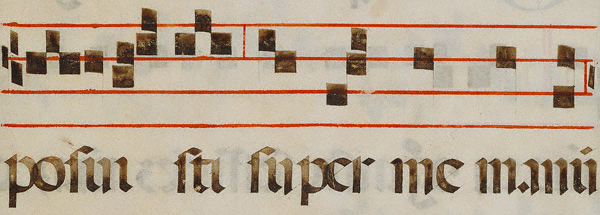|
Neumes
Beginning in the 800s in Europe, music was transcribed through a form of musical notation known as neumes, probably from the Greek word meaning "gesture."
Neumes are a series of ascending and descending dots and lines that gave the reader a sense of the rise and fall of the melody and how long each word of the chant should be held. Since most readers of early music manuscripts knew the basic tunes by heart, the neumes simply reminded singers of the melody.
 Hear a vocalist perform the music written on the page below. Hear a vocalist perform the music written on the page below.
|
 |
 |
 |
|
Music notation using neumes from a page of the Stammheim Missal featuring an Inhabited Initial B, German, about 1170s |
 |
Square Notation
As chants became more elaborate in the 1100s, the flexible neume form was gradually replaced by small squares written along a horizontal, four-line staff. Each staff line represented a specific pitch, and a series of notes thus indicated a distinct tune. This square notation later gave birth to our modern musical notes, written in rounded forms on a five-line staff.
 Hear a vocal ensemble perform the music written on the page below. Hear a vocal ensemble perform the music written on the page below.
|
 |
 |
 |
 |
|
Music notation using square notes from a page of a gradual featuring an Initial R, Italian, late 1400s or early 1500s |
 |

